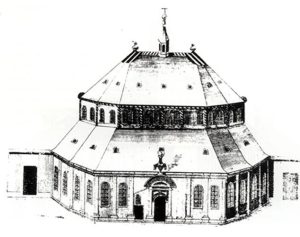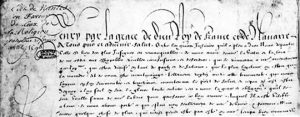The temple in Bourg-l'Abbé, a temple outside the city
As stipulated by the Edict of Nantes, the Caen temple was built outside the city, at Bourg-l’Abbé (1611-1612). It was of the centred pattern with canted walls and a double roof. It was topped by a small turret with a bell, and finials at all angles.
The smaller sides consisted of two bays, separated by colossal pilasters, with semi-circular windows. Of the five bays on the long side, the middle one corresponded to the door with an arched pediment topped with a finial. The same plan could be found on the first floor.
Surprised by the unusual aspect of this place of worship, the Catholic population mockingly called it the “forcemeat pie” or “pie crust”.
It was destroyed after the Revocation of the Edict of Nantes, and we know it only from documentary sources.



